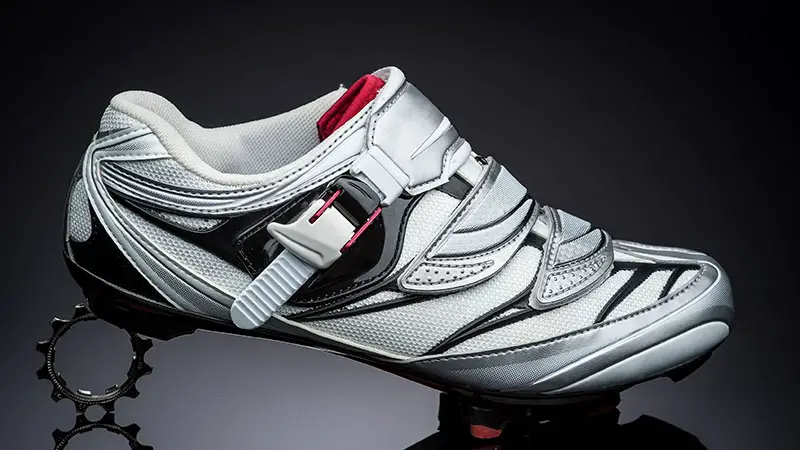Whether it is a pair of Jimmy Choo’s, Jordan’s, hiking boots, or cycling shoes, the fit is equally important, if not more, as the name brand and the look. When trying to figure out how cycling shoes should fit, you will probably have several questions. Of course, you want to enjoy wearing your new biking shoes, so the style is important, but there are some things that you will want to consider before you hop on your bike. Whether you ride a mountain bike, road bike, or take spinning classes, finding the proper pair of cycling shoes is just one factor to consider when preparing for your next adventure.
Contents
For the casual bike rider, a pair of runners is the usual shoe of choice when going for a casual bike ride on a sunny day. Heck, as a kid, a pair of flip-flops or bare feet would suffice as we would pedal around the neighborhood. However, neither of those would suffice as the proper footwear for competitive or adventure cycling. When was the last time you saw an Olympic cyclist or even a road rider in a pair of Nikes? We can say the same for mountain bikers and even Peloton riders. To get the most out of your next ride, many important factors come into play when choosing the right pair of cycling shoes.
How Cycling Shoes Should Fit – Important Factors

Length
As it is with a Nike basketball shoe and an Adidas shoe, a size ten in one brand of cycling shoe may differ slightly from another brand. Unlike regular shoes which touch the ground and roll to the side or back and forth, you do not move that much in your cycling shoes.
While a millimeter or two from the big toe to the tip of the inside of the shoe is acceptable to prevent any cramping in your feet, you want your cycling shoe to fit snug, almost to the point in which downsize ½ a size from your regular shoe size. If your cycling shoe is too long, the cleats may not mount properly and you may lose power in your pedaling.
- The SH-RP100 (RP1) is a Versatile 5-Hole Outsole: Compatible with both SPD / 2-hole and SPD-SL 3-hole cleats and clip-in pedals
- Stiff and Lightweight Sole: Fibreglass reinforced sole for maximum power transfer
- Simple and Secure Fit: Double strap closure for a comfortable and snug fit
- Durable Construction: Made from synthetic leather for long-lasting performance
- Pedaling Performance: Comfortable fit and optimum support for pedaling power and efficiency
Width
The front and the ball of your foot are the widest part of your feet, two key areas which contact the pedal and the points at which you exert pressure to power your bicycle. It is best to try on cycling shoes later in the day when your foot is a little wider because of having walked around or standing.
When trying on a pair of cycling shoes, sit down and make a pedaling motion with your feet (even better if the store has an indoor bike that you can test on). If you feel any uncomfortable pressure in these two key areas, then clearly you have the wrong shoe. For people who have narrow heels, you might want to purchase a shoe with a heel retention device that will allow the heel of the shoe to be narrowed.
Heel Support
The ideal cycling shoe will provide you with a firm fit in the heel area, one that will keep you from slipping out of your shoe while pedaling or walking, but will not cause you any pain or pinching. When you properly seat your heel in the shoe, your heel must not be able to move, with the shoe sitting firmly on the back of your foot.
Good Insoles
No products found.
As with any athletic shoe, all cycling shoes come equipped with a factory-fitted basic insole. While this insole provides the primary function of cushioning your foot, it may not be the proper insole for your biomechanics. By placing the foot in the proper position within the shoe, the right insole will allow for optimal transfer of force. The right pair of insoles will also help elevate mid-lower back, knee, and foot pains, while also adding arch support, making for a much more comfortable ride.
Being that every human has different feet, whether they are over-pronated, flat, medium, or high arched, cycling insoles may help deal with:
· postural imbalance
· sore and numb feet
· lack of stability
· metatarsalgia (inflamed feet balls)
Even if you are happy with the fit of the original insole, we always recommend a new set to help deal with any odor issues. 🙂
Quality Closure
Like regular runners, cycling shoes come equipped with a locking system that can comprise either or all of the laces, buckles, Velcro, and/or twist fasteners that keep the shoe firmly around the entire foot. Having a quality closure system that keeps your shoes in place and supportive is key to optimal stability and performance. One downside to the old fashion laces option is that they do not allow for mid-ride adjustments. Unlike buckles, Velcro, or twist fasteners, which you can just settle into a cruise mode, laces require stopping, unclipping, and getting off your bike to retie your shoe.
Rigid Sole and Solid Uppers
While it seems odd to say that the stiffer the sole of your bike shoe the better it is, in terms of both comfort and performance, it is true. Unlike other sports shoes, which are flexible and allow your foot to move and bend as you plant to change directions or jump, cycling shoes are more solid and stiff to optimize energy and power.
A stiff sole and solid upper will help to keep your foot stable and assist from any fatigue. Although there are areas in which you want the material on the upper portion of the shoe to be stiff, such as the power transmission points, you also want some softness in the sensitive parts of the foot for comfort.
Pedal Power

There are many types of pedal systems for various bikes, so it is important to select the proper shoe with the best fit, performance, and technology that suits your type of bike, pedal, and riding style. There are two categories of pedals – flat or clipless (clip-in), and sometimes you may come across pedals that have both a flat side and a clipless side.
Flat pedals are more commonly found on recreational bicycles and mountain bikes, allowing you to just hop on and off as you see fit. Flat pedals will allow you to adjust the position of your feet and also allow you to put your foot (feet) down when handling tight corners, avoiding a fall, or needing to stop in an emergency.
Clipless (clip-in) pedals go hand-in-hand with cleated shoes that attach from the bottom of your shoe to the pedal. Used for riders who seek to feel more connected with their bike and perform at a higher cadence and with more power for competitive racing and performance riding. Clipless pedals come in either a 2-bolt or 3-bolt style.
No products found.
As for why they are called clipless? Back in the day, flat pedals used to come with metal toe cages and leather straps to keep the rider’s feet attached to the pedal (called clips).
The Importance of Correct Fit For Cycling Shoes
Over the years, just as road bikes, mountain bikes, and indoor bikes have improved, cycling shoes have evolved, but their purpose remains the same – improved performance and biking experience. When purchasing a bike, we often look for the lightest frames, sculpted bars, fancy wheels, state-of-the-art shocks, and all the rest of the bells and whistles, but often we forget the one main contact area that we have with our bikes other than the seat, our feet.
Figuring out which type of footwear you need will also help you figure out the correct fit for your cycling shoes. For those who are commuting and stopping at traffic lights or walking, consider a pair of casual shoes or mountain bike shoes that have cleats embedded into the soles. Competitive cyclists log a lot of miles and hours on their feet and when you consider how much you are asking from your feet, you understand that a properly fitting cycling shoe will make you that much happier when you are riding in comfort.
How Tight Should Cycling Shoes Be?
There is a difference between fitting tight and fitting snug. If your toes are crammed into the tops of your shoes and curled up, your shoes are too tight. If your shoes are leaving you with cramps while riding and blisters all over your feet, they are too tight or too loose. As mentioned, when you consider the time that you spend riding your bike, you want a comfortable experience.
As cycling shoes rarely stretch that much over time, your feet should feel and fit comfortably from the first time you slip into your shoes. Having improperly fitting cycling shoes will not only impact your enjoyment of riding, but they may also cause health issues with your feet.
How Cycling Shoes Should Fit FAQs
How thick should your socks be when wearing cycling shoes?
Ideally wear a pair of snug-fitting, polyester, moisture-wicking socks. You may wish to wear ankle socks in the hotter summer months and calf-length socks in the winter. For those who ride in the colder months, you can wear wool socks so your feet remain dry and warm. But they can be on the bulky side, so you may wish to have a “winter” pair of shoes that will accommodate thicker socks.
How much do cycling shoes cost?
As with any shoes, the price range varies. However, shelling out more money doesn’t always equate to getting the best pair of shoes for your personal needs and style. Generally, more expensive shoes are made of better materials, and have better closures and ventilation. Yet some cyclists find they prefer a more flexible sole, which often comes with less expensive shoes. Lower budget shoes start at approximately $75, while high-end models can cost more than $500.
How long do cycling shoes last?
Whereas regular shoes can wear out within a year or two (depending on their use), cycling shoes will often last you for several years. Made from durable synthetic materials, road cycling shoes may last between 10-15 years. Factors such as your riding style, how much you use and care for them, the weather you use them in and the quality of shoes will play into how long they will last.
Can you walk in cycling shoes?
Despite your goal of hitting the open road and riding forever, hunger and nature may come calling, requiring you to hop off your bike and take a break, which could require a bit of a walk. While it is possible to walk in your clipless cycling shoes, it can be difficult. With the clip/cleat positioned near the ball of your foot, minimal arch support, and a small heel pad, walking can be uncomfortable and challenging.

